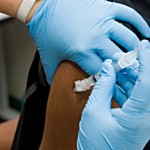 A flu vaccine derived from cell-culture is as effective as currently available flu vaccines, but would be less susceptible to manufacturing problems. It would also be possible to incorporate that year’s predicted seasonal strains into the vaccine much later than is currently possible, reducing the chances of error. The findings appear in an Article published Online First by The Lancet, written by Dr P Noel Barrett, Baxter BioScience, Biomedical Research Centre, Orth/Donau, Austria, and colleagues.
A flu vaccine derived from cell-culture is as effective as currently available flu vaccines, but would be less susceptible to manufacturing problems. It would also be possible to incorporate that year’s predicted seasonal strains into the vaccine much later than is currently possible, reducing the chances of error. The findings appear in an Article published Online First by The Lancet, written by Dr P Noel Barrett, Baxter BioScience, Biomedical Research Centre, Orth/Donau, Austria, and colleagues.
Vaccines derived from cell culture are produced in state-of-the-art manufacturing facilities using well-characterised cell lines which are available in unlimited amounts and allow reliable and flexiblevaccine supply. Currently most influenza vaccines are produced using embryonated hens’ eggs. This is a cumbersome process and manufacturing difficulties have led to vaccine shortages in the past. The use of cell culture overcomes these problems by utilizing standardized, closed manufacturing systems which allow for more reliable production and supply of influenza vaccines.
In this study, the authors analysed a vaccine derived from Vero-cell-culture. Vero cells are very well characterised and have been used for over 25 years for the production of human vaccines such aspolio and rabies, and, more recently also rotavirus vaccine, of which hundreds of millions of doses have been safely used.
A randomized controlled phase 3 trial was carried out in 36 centres in the USA, in which healthy adults (aged 18-49 years)were assigned in a 1:1 ratio to one injection of either placebo or Vero-cell-culture-derived influenza vaccine during the2008-09 season. A total of 7250 participants were randomly assigned to vaccine (n=3626) and placebo (n=3624). Overall protective efficacy for antigenically-matched influenza infection was 78,5%. The authors say that this compared well with current egg-derived vaccines, with one recent review reporting average protective efficacy of 73% when the vaccine strains matched circulating strains.
The new vaccine was well tolerated with no treatment-related serious adverse events. Adverse events were mainly mild and transient. The antibody response (level of antibodies required for protection) produced by the new vaccine was similar to existing vaccines.
In a linked Comment, Dr W Paul Glezen Department of Molecular Virology and Microbiology, Baylor College of Medicine,Houston, TX, USA, says: “The key to influenza control is the dependable availability of sufficient quantities of vaccine early in the season, preferably in August in the northern hemisphere. This schedule will allow more time for vaccine delivery…Safe vaccines which contain antigens that closely resemble the epidemic viruses will assure the likelihood of protection,and increase the demand for vaccine.”
Courtesy of www.infection-research.de

















